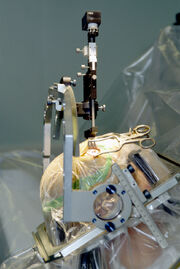Assessment |
Biopsychology |
Comparative |
Cognitive |
Developmental |
Language |
Individual differences |
Personality |
Philosophy |
Social |
Methods |
Statistics |
Clinical |
Educational |
Industrial |
Professional items |
World psychology |
Clinical: Approaches · Group therapy · Techniques · Types of problem · Areas of specialism · Taxonomies · Therapeutic issues · Modes of delivery · Model translation project · Personal experiences ·

Insertion of electrode during parkinson surgery.
Neurosurgery is the surgical discipline focused on treating those central and peripheral nervous system diseases amenable to mechanical intervention.
Definition and scope[]
| “ | Neurological Surgery is a discipline of medicine and that specialty of surgery which provides the operative and nonoperative management (ie, prevention, diagnosis, evaluation, treatment, critical care, and rehabilitation) of disorders of the central, peripheral, and autonomic nervous systems, including their supporting structures and vascular supply; the evaluation and treatment of pathological processes that modify the function or activity of the nervous system, including the hypophysis: and the operative and nonoperative management of pain. As such, neurological surgery encompasses the surgical, nonsurgical and stereotactic radiosurgical treatment of adult and pediatric patients with disorders of the nervous system: disorders of the brain, meninges, skull base, and their blood supply, including the surgical and endovascular treatment of disorders of the intracranial and extracranial vasculature supplying the brain and spinal cord; disorders of the pituitary gland; disorders of the spinal cord, meninges, and vertebral column, including those that may require treatment by fusion, instrumentation,or endovascular techniques; and disorders of the cranial and spinal nerves throughout their distribution. | ” |
Neurosurgical methods[]
Neuroradiology methods are used in modern neurosurgical diagnosis and treatment, including computer assisted imaging computed tomography (CT), magnetic resonance imaging (MRI), positron emission tomography (PET), magnetoencephalography (MEG), and the stereotactic surgery. Some neurosurgical procedures involve the use of MRI and functional MRI intraoperatively.
Microsurgery is utilized in many aspects of neurological surgery. Microvascular anastomosis are required when EC-IC surgery is performed. The clipping of aneurysms is performed using a microscope. Minimally invasive spine surgery utilizes these techniques. Procedures such as microdiscectomy, laminectomy, and artificial discs rely on microsurgery.[1]
Minimally invasive endoscopic surgery is utilized by neurosurgeons. Techniques such as endoscopic endonasal surgery is used for pituitary tumors, craniopharyngiomas, chordomas, and the repair of cerebrospinal fluid leaks. Ventricular endoscopy is used for colloid cysts and neurocysticercosis. Endoscopic techniques can be used to assist in the evaculation of hematomas and trigeminal neuralgia. Repair of craniofacial disorders and disturbance of cerebrospinal fluid circulation is done by neurosurgeons, and depending on the situation, plastic surgeons. Conditions such as chiari malformation, craniosynostosis, and syringomyelia are treated. This is called cranioplasty.
Neurosurgeons are involved in Stereotactic Radiosurgery along with Radiation Oncologists for tumor and AVM treatment. Radiosurgical methods such as Gamma knife, Cyberknife and Novalis Shaped Beam Surgery are used.[2]
Neurosurgeons have begun to utilize endovascular image guided procedures for the treatment of aneurysms, AVMs, carotid stenosis, strokes, and spinal malformations, and vasospasms. Also, nonvascular procedures such as Vertoplasty and Kyphoplasty are used by neurosurgeons. Techniques such as angioplasty, stenting, clot retrieval, embolization, and diagnostic angiography are utilized.[3]
Procedures[]
These include:
- Commissurotomy
- Decerebration
- Decortication (brain)
- Hemispherectomy
- Pyramidectomy
- Sympathectomy
- Tractotomy
- Vagotomy
Conditions[]
Neurosurgical conditions include primarily brain, spinal cord and peripheral nerve disorders.
Conditions treated by neurosurgeons include:
- Spinal disc herniation
- Spinal stenosis
- Hydrocephalus
- Head trauma (brain hemorrhages, skull fractures, etc.)
- Spinal cord trauma
- Traumatic injuries of peripheral nerves
- Brain tumors
- Tumors of the spine, spinal cord and peripheral nerves
- Cerebral aneurysms
- Some forms of hemorrhagic stroke, such as subarachnoid hemorrhages, as well as intraparenchymal and intraventricular hemorrhages
- Some forms of pharmacologically resistant epilepsy
- Some forms of movement disorders (advanced Parkinson's disease, chorea, hemiballism) - this involves the use of specially developed minimally invasive stereotactic techniques (functional, stereotactic neurosurgery)
- Intractable pain of cancer or trauma patients and cranial/peripheral nerve pain
- Some forms of intractable psychiatric disorders
- Malformations of the nervous system
- Carotid artery stenosis
- Arteriovenous malformations of the brain and spinal cord
- Carpal Tunnel Syndrome
- Moyamoya disease
Neurosurgery Journals[]
- 'British Journal of Neurosurgery' (Informa Healthcare) | Published in association with the Society of British Neurological Surgeons
- Neurology India
- Neurosurgery
- Journal of Neurosurgery
- Surgical Neurology
- Nimhans Journal
See also[]
References & Bibliography[]
External links[]
- Congress of Neurological Surgeons
- American Association of Neurologic Surgeons
- American Board of Neurological Surgery
- Neurosurgical Society of Australasia
- Brain Surgery-Neurosurgery Patient Help Site
- European Association of Neurosurgical Societies
- Neurology Society of India
- University of Florida Department of Neurosurgery
- Massachusetts General Hospital Department of Neurosurgery
Advance practice nursing - Audiology - Dentistry - Dietetics - Emergency medical services - Epidemiology - Medical technology - Midwifery - Nursing - Occupational therapy - Optometry - Osteopathic medicine - Pharmacy - Physical therapy (Physiotherapy) - Physician - Physician assistant - Podiatry - Psychology - Public health - Respiratory therapy - Speech and language pathology
Physician specialties: Anesthesiology - Dermatology - Emergency medicine - General practice (Family medicine) - Internal medicine - Neurology - Nuclear medicine - Occupational medicine - Pathology - Pediatrics - Physical medicine and rehabilitation (Physiatry) - Preventive medicine - Psychiatry - Radiation oncology - Radiology - Surgery
Medical subspecialties: Allergy and immunology - Cardiology - Endocrinology - Gastroenterology - Hematology - Infectious disease - Intensive care medicine (Critical care medicine) - Medical genetics - Nephrology - Oncology - Pulmonology - Rheumatology
Surgery, Nervous system: neurosurgical and other procedures (ICD-9-CM V3 01–05+89.1, ICD-10-PCS 00–01) | |||||||||||||||
|---|---|---|---|---|---|---|---|---|---|---|---|---|---|---|---|
| Skull |
Craniotomy · Craniectomy (Decompressive craniectomy) · Cranioplasty | ||||||||||||||
| CNS |
| ||||||||||||||
| PNS |
| ||||||||||||||
| {| class="navbox collapsible nowraplinks" style="margin:auto; " | |||||||||||||||
| |||||||||||||||
|
|}
| This page uses Creative Commons Licensed content from Wikipedia (view authors). |